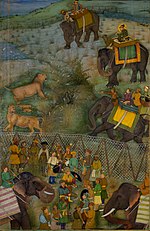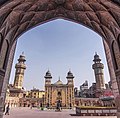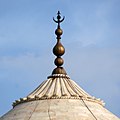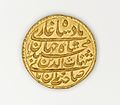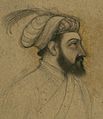Shah Jahan
Shah Jahan
| This article needs additional citations for verification. (May 2016) (Learn how and when to remove this template message) |
| Shah Jahan | |||||||||
|---|---|---|---|---|---|---|---|---|---|

Portrait of Shah Jahan seated on the Peacock Throne
|
|||||||||
| 5th Mughal Emperor | |||||||||
| Reign | 19 January 1628 – 31 July 1658[1][2] | ||||||||
| Coronation | 14 February 1628, Agra[3][4] | ||||||||
| Predecessor | Shahryar (de facto) Jahangir |
||||||||
| Successor | Aurangzeb | ||||||||
|
|
|||||||||
| Born | Shahāb-ud-Dīn Muḥammad Khurram[5] 5 January 1592 Lahore, Pakistan |
||||||||
| Died | 22 January 1666 (aged 74) Agra Fort, Agra, India |
||||||||
| Burial | Taj Mahal, Agra | ||||||||
| Spouse | Kandahari Begum Mumtaz Mahal Akbarabadi Mahal[6] Fatehpuri Mahal[6] |
||||||||
| Issue | |||||||||
|
|||||||||
| House | House of Timur | ||||||||
| Father | Jahangir | ||||||||
| Mother | Taj Bibi Bilqis Makani | ||||||||
| Religion | Islam | ||||||||
| Mughal emperors | |
| Babur | 1526 – 1530 |
| Humayun | 1530 – 1540 1555 – 1556 |
| Akbar | 1556 – 1605 |
| Jahangir | 1605 – 1627 |
| Shahryar (de facto) | 1627 – 1628 |
| Shah Jahan | 1628 – 1658 |
| Aurangzeb | 1658 – 1707 |
| Muhammad Azam Shah (titular) | 1707 |
| Bahadur Shah I | 1707 – 1712 |
| Jahandar Shah | 1712 – 1713 |
| Farrukhsiyar | 1713 – 1719 |
| Rafi ud-Darajat | 1719 |
| Shah Jahan II | 1719 |
| Muhammad Shah | 1719 – 1748 |
| Ahmad Shah Bahadur | 1748 – 1754 |
| Alamgir II | 1754 – 1759 |
| Shah Jahan III (titular) | 1759 – 1760 |
| Shah Alam II | 1760 – 1806 |
| Jahan Shah IV (titular) | 1788 |
| Akbar II | 1806 – 1837 |
| Bahadur Shah II | 1837 – 1857 |
| Empire abolished and replaced by British Raj | |
Shahab-ud-Din Muḥammad Khurram[5] (5 January 1592 – 22 January 1666 OS)[8] better known by his regnal name, Shah Jahan (Persian: "King of the World"),[9] was the fifth Mughal emperor, who reigned from 1628 to 1658.
Emperor Jahangir's death, in late 1627, was a signal for a last paroxysm of fighting among his sons and their supporters. These fratricidal conflicts were carried out with ruthlessness and Jahangir's third son, Khurram, proved the most ruthless of all. He was crowned at Agra and his regnal name, Shah Jahan (originally given to him as a princely title), was read at the Jama Masjid there in January 1628. Shah Jahan maintained an aggressive military pressure along the interior frontiers of the Mughal Empire, as his predecessors had, but his lasting fame was not as a soldier. His artistic and architectural monuments have more than eclipsed his military exploits, beginning with the jewel-encrusted Peacock Throne and culminating in the Taj Mahal which entombed his beloved wife Mumtaz Mahal. His building programme was capped by the ambitious new capital in Delhi named for himself Shahjahanabad. Here, he erected a new fortress-palace, the Red Fort, and nearby an enormous mosque, Jama Masjid, on top of a hill, to convey symbolically the exalted status of Islam over the city's landscape.[10]
In matters of religion, his plain straightforward creed permitted no licence, although he never became a bigot. With the latitude of Akbar's religious beliefs and practices, and the looseness of Jahangir's court, he had no sympathy, and his objects were primarily to restore the strict profession of Islam rather than to persecute believers in other religions. In 1633, Shah Jahan ordered the demolition of Hindu temples which had been begun in the previous reign.[11][12] These orders were followed by a prohibition of the erection of new shrines or the repair of older buildings.[11] Intermarriage between Hindus and Muslims was forbidden in 1634. Shah Jahan, himself, sustained the established alliances at a political level and did not marry Hindu women, like his father and his grandfather had.[13][14] Mass conversions of Hindus to Islam were also encouraged, and in some cases were forcibly effected. All these acts, however, were dictated rather by the desire to maintain the strict tenets of Islam than to pursue the course of iconoclasm which was adopted by his son Aurangzeb.
In September 1657, Shah Jahan fell seriously ill,[15] which set off a war of succession among his sons, in which Aurangzeb (1618 –1707) emerged victorious. Shah Jahan recovered from his illness, but Aurangzeb kept his father under house arrest in Agra Fort from June 1658 until his death in 1666. On 31 July 1658, Aurangzeb crowned himself emperor with the title of Alamgir.[2]
The Mughal Empire reached the pinnacle of it's glory during Shah Jahan's reign and he is widely considered to be one of the greatest Mughal emperors. His reign is also described as the "Golden Age" of the Mughals.[16][17][18]
Early life[edit]
Birth[edit]
Shahab-ud-din Muhammad Khurram was born on 5 January 1592 in Lahore to Prince Salim (the future emperor Jahangir) and his second wife, a Rajput princess from Marwar called Jagat Gosaini (her official name in Mughal chronicles was Bilqis Makani).[19] The name 'Khurram' ("joyous") was chosen for the young prince by his grandfather, Akbar, with whom he shared an extremely close relationship.[20]
Just prior to Khurram's birth, a soothsayer had reportedly predicted to the childless Empress Ruqaiya Sultan Begum (Akbar's first wife and chief consort) that the still unborn child was destined for imperial greatness.[21] So, when Khurram was born in 1592 and was only six days old; Akbar ordered that the prince be taken away from his mother and handed him over to Ruqaiya so that he could grow up under her care and Akbar could fulfill his wife's wish, to raise a Mughal emperor.[21]Ruqaiya assumed the primary responsibility for Khurram's upbringing and he grew up under her care.[22] Her step-son, Jahangir, noted that Ruqaiya had loved his son, Khurram, "a thousand times more than if he had been her own [son]."[23]
Khurram remained with her until he had turned 13. After the death of Akbar, the young prince was allowed to return to his father's household, and thus, be closer to his biological mother.[21]
Education[edit]
As a child, Khurram received a broad education befitting his status as a Mughal prince, which included martial training and exposure to a wide variety of cultural arts, such as poetry and music, most of which was inculcated, according to court chroniclers, under the watchful gaze of his grandfather, Emperor Akbar, and his step-grandmother, Empress Ruqaiya. In 1605, as the Akbar lay on his deathbed, Khurram, who at this point was 13,[24][full citation needed] remained by his bedside and refused to move even after his mother tried to retrieve him. Given the politically uncertain times immediately preceding Akbar's death, Khurram was in a fair amount of physical danger of harm by political opponents of his father and his conduct at this time can be understood to be a precursor to bravery that he would later be known for.[citation needed]
Khusraw rebellion[edit]
In 1605, his father succeeded to the throne, after crushing a rebellion by Prince Khausrau – Khurram remained distant from the court politics and intrigues in the immediate aftermath of that event, which was apparently a conscious decision on Jahangir's part.[25] As the third son, Khurram did not challenge the two major power blocs of the time, his father's and his step-brother's; thus he enjoyed the benefits of Imperial protection and luxury, while being allowed to continue with his education and training.[26] This relatively quiet and stable period of his life allowed Khurram to build his own support base in the Mughal court, which would be useful later on in his life.[citation needed]
Nur Jahan[edit]
Due to the long period of tensions between his father and step-brother, Khurram began to drift closer to his father and over time started to be considered the de facto heir apparent by court chroniclers. This status was given official sanction when Jahangir granted the jagir of Hissar-Feroza, which had traditionally been the fief of the heir apparent, to Khurram in 1607.[27][page needed] Nur Jahan was an intelligent and beautiful lady with an excellent educational background. She was an active participant in the decisions made by Jahangir. Slowly and gradually, she became the actual power behind the throne, as Jahangir became more indulgent in wine and opium. Coins began to be struck containing her name along with jahangir's name. Her near and dear relatives acquired important positions in the mughal court. It has been termed as Nur Jahan junta by the historians. After the death of Jahangir in 1627, Nur jahan stepped down from politics and led a quiet life.
Marriages[edit]
In 1607, Khurram became engaged to Arjumand Banu Begum (1593–1631), who is also known as Mumtaz Mahal. They met in their youth. They were about 14 and 15 when they engaged, and five years later they got married. The young girl belonged to an illustrious Persian noble family which had been serving Mughal Emperors since the reign of Akbar, the family's patriarch was Mirza Ghiyas Beg, who was also known by his title I'timād-ud-Daulah or "Pillar of the State". He had been Jahangir's finance minister and his son; Asaf Khan – Arjumand Banu's father – played an important role in the Mughal court, eventually serving as Chief Minister. Her aunt was the Empress Nur Jahan, who had arranged the marriage.[28]
The prince would, however, have to wait five years before he was married in 1612 AD (1021 AH), on a date selected by the court astrologers as most conducive to ensuring a happy marriage. This was an unusually long engagement for the time. However, Shah Jahan first married Princess Kandahari Begum, the daughter of a great-grandson of Shah Ismail I of Persia with whom he had a daughter, his first child.[29]
Politically speaking, the betrothal allowed Khurram to be considered as having officially entered manhood, and he was granted several jagir, including Hissar-Feroze and ennobled to a military rank of 8,000, which allowed him to take on official functions of state, an important step in establishing his own claim to the throne.[citation needed]
In 1612, aged 20, Khurram married Arjumand Banu Begum, who became known by the title Mumtaz Mahal, on the auspicious date chosen by court astrologers. The marriage was a happy one and Khurram remained devoted to her. She bore him fourteen children, out of whom seven survived into adulthood. In addition, Khurram had two children from his first two wives.[29]
Though there was genuine love between the two, Arjumand Banu Begum was a politically astute woman and served as a crucial advisor and confidante to her husband.[30] Later on, as empress, Mumtaz Mahal (Persian: the chosen one of the Palace) wielded immense power, such as being consulted by her husband in state matters and being responsible for the imperial seal, which allowed her to review official documents in their final draft.[citation needed]
Mumtaz Mahal died, aged 37 (7 July 1631), while giving birth to Gauhara Begum in Burhanpur, the cause of death being postpartum haemorrhage, which caused considerable blood-loss after a painful labour of thirty hours.[31] Contemporary historians note that Princess Jahanara, aged 17, was so distressed by her mother's pain that she started distributing gems to the poor, hoping for divine intervention and Shah Jahan, himself, was noted as being "paralysed by grief" and weeping fits.[32] Her body was temporarily buried in a walled pleasure garden known as Zainabad, originally constructed by Shah Jahan's uncle Prince Daniyal along the Tapti River. Her death had a profound impact on Shah Jahan's personality and inspired the construction of the Taj Mahal, where she was later reburied.[citation needed]
The intervening years had seen Khurram take three other wives, Kandahari Begum (m. 12 December 1609) and Izz un-Nisa Begum (m. 3 September 1617), the daughters of Muzaffar Husain Mirza Safawi and Shahnawaz Khan, son of Abdul Rahim Khan-I-Khana, respectively. But according to court chroniclers, his relationship with his other wives was more out of political consideration and they enjoyed only the status of being royal wives.[33]
Military commander[edit]
The first occasion for Khurram to test out his military prowess was during the Mughal campaign against the Rajput state of Mewar, which had been a hostile force to the Mughals since Akbar's reign. In 1614, commanding an army numbering around 200,000, Khurram began the offensive against the Rajput kingdom. After a year of the harsh war of attrition, Maharana Amar Singh II surrendered to the Mughal forces with the condition that Ruler of Mewar is not required to attend Mughal Durbar and became a vassal state of the Mughal Empire.[citation needed]
In 1617, Khurram was directed to deal with the Lodi in the Deccan, to secure the Empire's southern borders and to restore imperial control over the region. His successes in these conflicts led to Jahangir granting him the title of Shah Jahan (Persian: King of the World) and raised his military rank and allowed him a special throne in his Durbar, an unprecedented honour for a prince, thus further solidifying his status as crown prince.[citation needed]
Rebel prince[edit]
Inheritance of power and wealth in the Mughal empire was not determined through primogeniture, but by princely sons competing to achieve military successes and consolidating their power at court. This often led to rebellions and wars of succession. As a result, a complex political climate surrounded the Mughal court in Khurram's formative years. In 1611 his father married Nur Jahan, the widowed daughter of a Persian noble. She rapidly became an important member of Jahangir's court and, together with her brother Asaf Khan, wielded considerable influence. Arjumand was Asaf Khan's daughter and her marriage to Khurram consolidated Nur Jahan and Asaf Khan's positions at court.
Court intrigues, however, including Nur Jahan's decision to have her daughter from her first marriage wed Prince Khurram's youngest brother Shahzada Shahryar and her support for his claim to the throne led to much internal division. Prince Khurram resented the influence Nur Jahan held over his father and was angered at having to play second fiddle to her favourite Shahryar, his half-brother and her son-in-law. When the Persians besieged Kandahar, Nur Jahan was at the helm of the affairs. She ordered Prince Khurram to march for Kandahar, but he refused. As a result of Prince Khurram's refusal to obey Nur Jahan's orders, Kandahar was lost to the Persians after a forty-five-day siege.[citation needed] Prince Khurram feared that in his absence Nur Jahan would attempt to poison his father against him and convince Jahangir to name Shahryar the heir in his place. This fear brought Prince Khurram to rebel against his father rather than fight against the Persians. In 1622 Prince Khurram raised an army with the support of Mahabat Khan and marched against his father and Nur Jahan.[citation needed]. He was defeated at Bilochpur in March 1623. Later he took refuge in Udaipur Mewar with Maharaja Karan Singh II . He was first lodged in Delwada Ki Haveli and subsequently shifted to Jagmandir Palace on his request. Prince Khurram exchanged his turban with maharana and that turban is still preserved in Pratap Museum, Udaipur.(R V Somani 1976). It is believed that mosaic work of Jagmandir inspired him to use mosaic work in Taj Mahal of Agra. His rebellion did not succeed and Khurram was forced to submit unconditionally. Although the prince was forgiven for his errors in 1626, tensions between Nur Jahan and her stepson continued to grow beneath the surface. Upon the death of Jahangir in 1627, Khurram succeeded to the Mughal throne as Abu ud-Muzaffar Shihab ud-Din Mohammad Sahib ud-Quiran ud-Thani Shah Jahan Padshah Ghazi (Urdu: شهاب الدین محمد خرم), or Shah Jahan.[34]
His regnal name is divided into various parts. Shihab ud-Din mean "Star of the Faith", Sahib al-Quiran ud-Thani means "Second Lord of the Happy Conjunction of Jupiter and Venus". Shah Jahan means "King of the World", alluding to his pride in his Timurid roots and his ambitions. More epithets showed his secular and religious duties. He was also Khalifat Panahi ("Refuge of the Caliphate"), but Zill-i Allahi, or the "Shadow of God on Earth".[citation needed]
His first act as ruler was to execute his chief rivals and imprison his step mother Nur Jahan. Upon Shah Jahan's orders several executions took place on 23 January 1628. Those put to death included his own brother Shahryar; his nephews Dawar and Garshasp, sons of Shah Jahan's previously executed brother Prince Khusrau; and his cousins Tahmuras and Hoshang, sons of the late Prince Daniyal.[35][36] This allowed Shah Jahan to rule his empire without contention.
Governorship[edit]
Deccan 1611–1612 Bihar 1613–1614 Gujarat 1614–1618 Delhi 1623–1627 Bengal 1624–1625 Bihar 1625–1627
Reign (1628 –1658)[edit]
Administration of the Mughal Empire[edit]
Evidence from the reign of Shah Jahan states that in 1648 the army consisted of 911,400 infantry, musketeers, and artillery men, and 185,000 Sowars commanded by princes and nobles.
During his reign the Marwari horse was introduced, becoming Shah Jahan's favourite, and various Mughal cannons were mass-produced in the Jaigarh Fort. Under his rule, the empire became a huge military machine and the nobles and their contingents multiplied almost fourfold, as did the demands for more revenue from the peasantry. But due to his measures in the financial and commercial fields, it was a period of general stability—the administration was centralised and court affairs systematised.
The Mughal Empire continued to expand moderately during his reign as his sons commanded large armies on different fronts. India at the time was a rich centre of the arts, crafts and architecture, and some of the best of the architects, artisans, craftsmen, painters and writers of the world resided in Shah Jahan's empire. It is believed that at the time the Mughal Empire had the highest gross domestic produce in the world.[37][38]
Rajput revolutionaries[edit]
Shah Jahan annexed the Rajput confederates of Baglana, Mewar and Bundelkhand. He then chose his 16-year-old son Aurangzeb to serve in his place and subdue the rebellion by the Bundela Rajputs led by Jhujhar Singh.
Famine of 1630[edit]
A famine broke out in 1630–32 in Deccan, Gujarat and Khandesh as a result of three main crop failures.[39] Two million died of starvation, parents ate their children, grocers sold dogs' flesh and mixed powdered bones with flour. Some villages were completely destroyed, their streets filled with human corpses. In response to the devastation, Shah Jahan set up soup-kitchen (Langar) for the victims of the famine.[40]
Relations with the Deccan Sultanates[edit]
Shah Jahan captured the fortress at Daulatabad, Maharashtra, in 1632, and imprisoned Husain Shah of the Nizam Shahi Kingdom of Ahmednagar. Golconda submitted in 1635 and then Bijapur in 1636. Shah Jahan appointed Aurangzeb as Viceroy of the Deccan, consisting of Khandesh, Berar, Telangana, and Daulatabad. During his viceroyalty, Aurangzeb conquered Baglana, then Golconda in 1656, and then Bijapur in 1657.[41]:170–171
Sikh rebellion led by Guru Hargobind[edit]
A rebellion of the Sikhs led by Guru Hargobind took place and in return Shah Jahan ordered the destruction of the Sikh temple in Lahore. Skirmishes were fought at Amritsar, Kartarpur and elsewhere. Battle of Amritsar (1634), Battle of Kartarpur
Relations with the Safavid dynasty[edit]
Shah Jahan and his sons captured the city of Kandahar in 1638 from the Safavids, prompting the retaliation of the Persians led by their powerful ruler Abbas II of Persia, who recaptured it in 1649.
The Mughal armies were unable to recapture it despite repeated sieges during the Mughal–Safavid War.."[41] Shah Jahan also expanded the Mughal Empire to the west beyond the Khyber Pass to Ghazna and Kandahar.
Relations with the Ottoman Empire[edit]
While he was encamped in Baghdad, the Ottoman Sultan Murad IV is known to have met Shah Jahan's ambassadors: Mir Zarif and Mir Baraka, who presented 1000 pieces of finely embroidered cloth and even armour. Murad IV presented them with the finest weapons, saddles and Kaftans and ordered his forces to accompany the Mughals to the port of Basra, where they set sail to Thatta and finally Surat.[citation needed]
Shah Jahan had exchanged ambassadors and documents with the Murad IV, it was through these exchanges led by the Mughal ambassador Sayyid Muhiuddin and his counterpart the Ottoman ambassador Arsalan Agha, that Mughal Emperor Shah Jahan received Mimar Yusuf, Isa Muhammad Effendi and Ismail Effendi, two Turkish architects and students of the famous Koca Mimar Sinan Agha. Both of them later comprised among the Mughal team that would design and build the Taj Mahal.[citation needed]
War with Portuguese[edit]
Shah Jahan gave orders in 1631 to Qasim Khan, the Mughal viceroy of Bengal, to drive out the Portuguese from their trading post at Port Hoogly. The post was heavily armed with cannons, battleships, fortified walls, and other instruments of war.[42] The Portuguese were accused of trafficking by high Mughal officials and due to commercial competition the Mughal-controlled port of Saptagram began to slump. Shah Jahan was particularly outraged by the activities of Jesuits in that region, notably when they were accused of abducting peasants. On 25 September 1632 the Mughal Army raised imperial banners and gained control over the Bandel region and the garrison was punished.[43]
Patronage of the arts[edit]
Shah Jahan also intended to construct his capitol at Agra as an urban centre that would rival both Istanbul and Isfahan in all its wealth and cultural opulence.[citation needed]
Shah Jahan's reign saw some of India's most well-known architectural and artistic accomplishments. The land revenue of the Mughal Empire under Shah Jahan was higher than that of any other Mughal ruler. The magnificence of his court was commented upon by several European travellers and by ambassadors from other parts of the world, including Francois Bernier and Thomas Roe.[citation needed]
Shah Jahan was a prolific builder with a highly refined aesthetic sense. Among his surviving buildings are the Red Fort and Jama Masjid in Delhi, the Shalimar Gardens of Lahore, sections of the Lahore Fort(such as Sheesh Mahal, and Naulakha pavilion), and his Tomb of Jahangir.[citation needed]
Religious attitude[edit]
Shah Jahan was more radical in his thinking than his father and grandfather. Upon his accession, he adopted new policies which reversed Akbar's treatment of non-Muslims. In 1633, his sixth regnal year, Shah Jahan began to impose his interpretation of Sharia provisions against construction or repair of churches and temples and subsequently ordered the demolitions of newly built Hindu temples. He celebrated Islamic festivals with great pomp and grandeur and with an enthusiasm unfamiliar to his predecessors. Long-dormant royal interest in the Holy Cities was also revived during his reign.[44]
Ministers[edit]
Shah Jahan's treasurer was Shaikh Farid, who founded the city of Faridabad.
Later life[edit]
| This section needs additional citations for verification. (April 2015) (Learn how and when to remove this template message) |
When Shah Jahan became ill in 1658, Dara Shikoh (Mumtaz Mahal's eldest son) assumed the role of regent in his father's stead, which swiftly incurred the animosity of his brothers. Upon learning of his assumption of the regency, his younger brothers, Shuja, Viceroy of Bengal, and Murad Baksh, Viceroy of Gujarat, declared their independence, and marched upon Agra in order to claim their riches. Aurangzeb, the third son, and ablest of the brothers, gathered a well trained army and became its chief commander. He faced Dara's army near Agra and defeated him during the Battle of Samugarh. Although Shah Jahan fully recovered from his illness, Aurangzeb declared him incompetent to rule and put him under house arrest in Agra Fort.
Jahanara Begum Sahib, Jahan's first daughter, voluntarily shared his 8-year confinement and nursed him in his dotage. In January 1666, Shah Jahan fell ill. Confined to bed, he became progressively weaker until, on 22 January, he commended the ladies of the imperial court, particularly his consort of later years Akbarabadi Mahal, to the care of Jahanara. After reciting the Kal'ma (Laa ilaaha ill allah) and verses from the Quran, Shah Jahan died, aged 74.
Shah Jahan's chaplain Sayyid Muhammad Qanauji and Kazi Qurban of Agra came to the fort, moved his body to a nearby hall, washed it, enshrouded it and put it in a coffin of sandalwood.[30]
Princess Jahanara had planned a state funeral which was to include a procession with Shah Jahan's body carried by eminent nobles followed by the notable citizens of Agra and officials scattering coins for the poor and needy.[45] Aurangzeb refused to accommodate such ostentation. The body was taken by river to the Taj Mahal and was interred there next to the body of his beloved wife Mumtaz Mahal.[46]
Contributions to architecture[edit]
Shah Jahan left behind a grand legacy of structures constructed during his reign. He was one of the greatest patrons of Mughal architecture.[47] His most famous building was the Taj Mahal, which he built out of love for his wife, the empress Mumtaz Mahal.
Its structure was drawn with great care and architects from all over the world were called for this purpose. The building took twenty years to complete and was constructed from white marble underlaid with brick. Upon his death, his son Aurangzeb had him interred in it next to Mumtaz Mahal. Among his other constructions are the Red Fort also called the Delhi Fort or Lal Qila in Urdu, large sections of Agra Fort, the Jama Masjid, the Wazir Khan Mosque, the Moti Masjid, the Shalimar Gardens, sections of the Lahore Fort, the Mahabat Khan Mosque in Peshawar, the Jahangir mausoleum—his father's tomb, the construction of which was overseen by his stepmother Nur Jahan and the Shahjahan Mosque. He also had the Peacock Throne, Takht e Taus, made to celebrate his rule. Shah Jahan also placed profound verses of the Quran on his masterpieces of architecture.[citation needed]
The Shah Jahan Mosque in Thatta, Sindh province of Pakistan (100 km / 60 miles from Karachi) was built during the reign of Shah Jahan in 1647. The mosque is built with red bricks with blue coloured glaze tiles probably imported from another Sindh's town of Hala. The mosque has overall 93 domes and it is world's largest mosque having such number of domes. It has been built keeping acoustics in mind. A person speaking inside one end of the dome can be heard at the other end when the speech exceeds 100 decibels. It has been on the tentative UNESCO World Heritage list since 1993.[48]
Coins[edit]
Shah Jahan continued striking coins in three metals i.e. gold (mohur), silver (rupee) and copper (dam). His pre-accession coins bear the name Khurram.
Full title[edit]
| Styles of Shah Jahan |
|
|---|---|
| Reference style | Padshah |
| Spoken style | His Imperial Majesty |
| Alternative style | Alam Pana |
His full title as emperor was:
Shahanshah Al-Sultan al-'Azam wal Khaqan al-Mukarram Malik-ul-Sultanat Ala Hazrat Abu'l-Muzaffar Shahab ud-din Muhammad Shah Jahan I Sahib-i-Qiran-i-Sani Padshah Ghazi Zillu'llah Firdaus-Ashiyani Shahanshah—E—Sultanant Ul Hindiya Wal Mughaliya
See also[edit]

